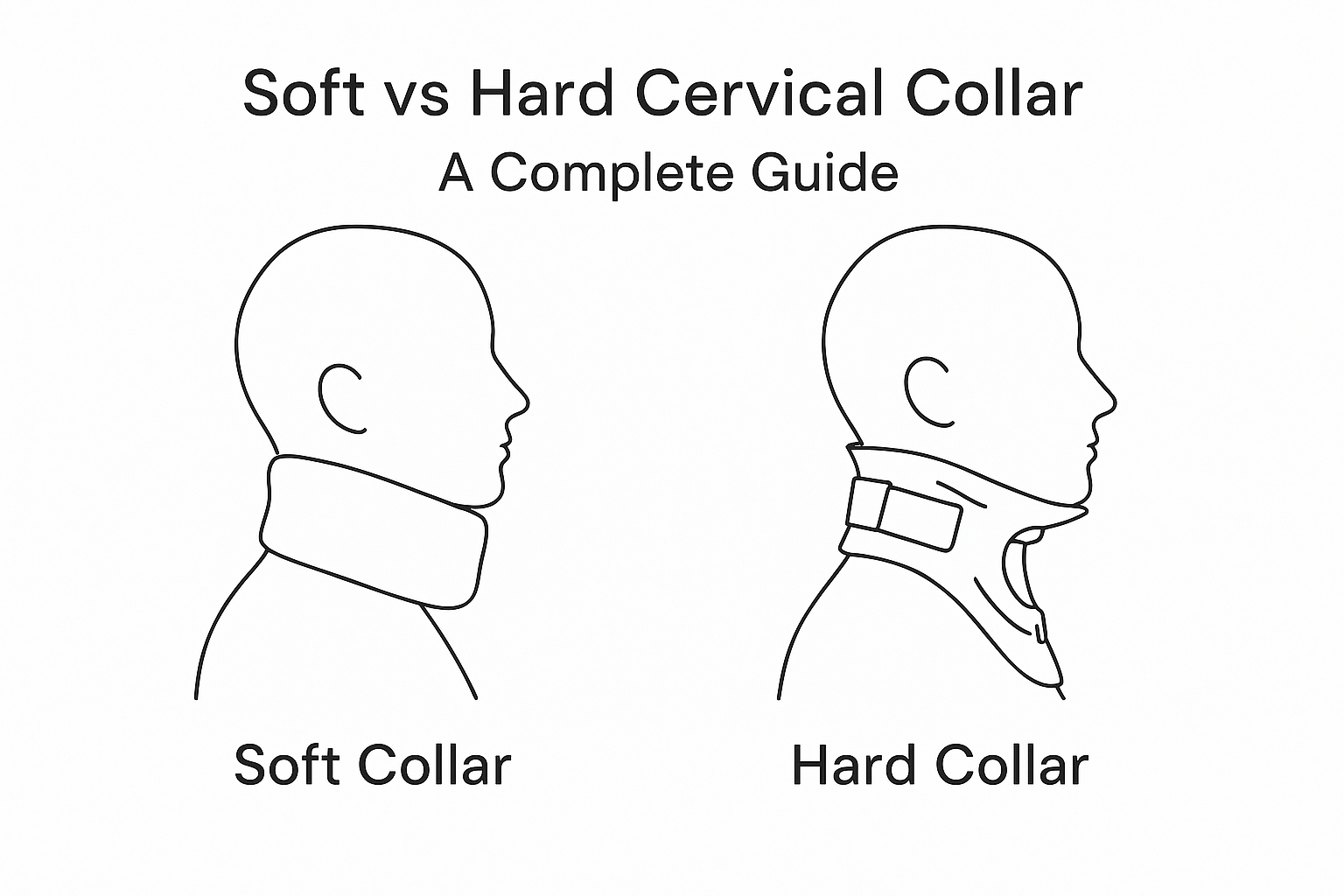Introduction
Neck pain is a common patient complaint, having a lifetime prevalence of 22-70% and an annual prevalence of 30-50%. Neck support is crucial for treating neck pain and injuries, and cervical collars are a common solution for this problem. They provide head and neck immobilisation to promote healing of neck muscles and soft tissues. When you’re suffering from serious neck pain or have been in a car accident, a cervical collar can provide the support you need to recover. However, the choice of collar is crucial.
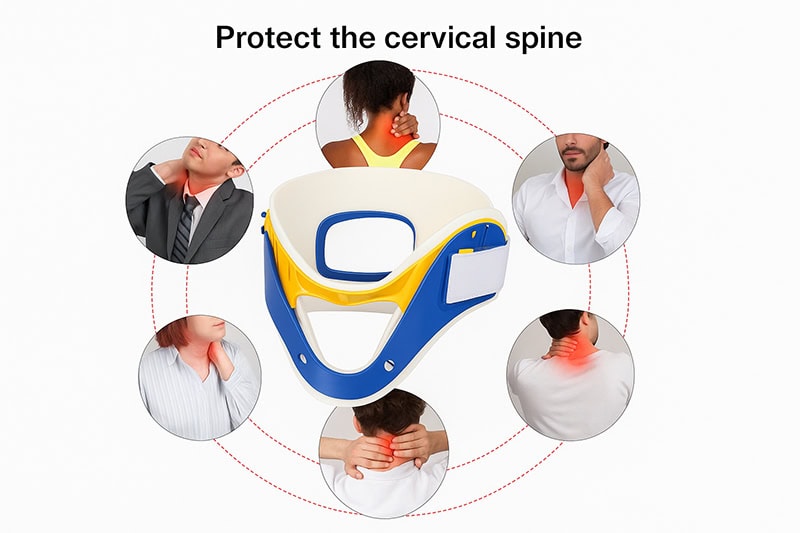
The question remains: Should you opt for a soft cervical collar that offers gentle support or a hard cervical collar designed for rigid immobilisation?
This guide will break down everything you need to know: clinical differences, comfort comparison, range of motion (ROM) restriction, price tiers, and fitting instructions. Whether you are a caregiver, healthcare professional, or a patient, this information will help you understand different types of cervical collars, so you can make an informed choice.
What are Cervical Collars
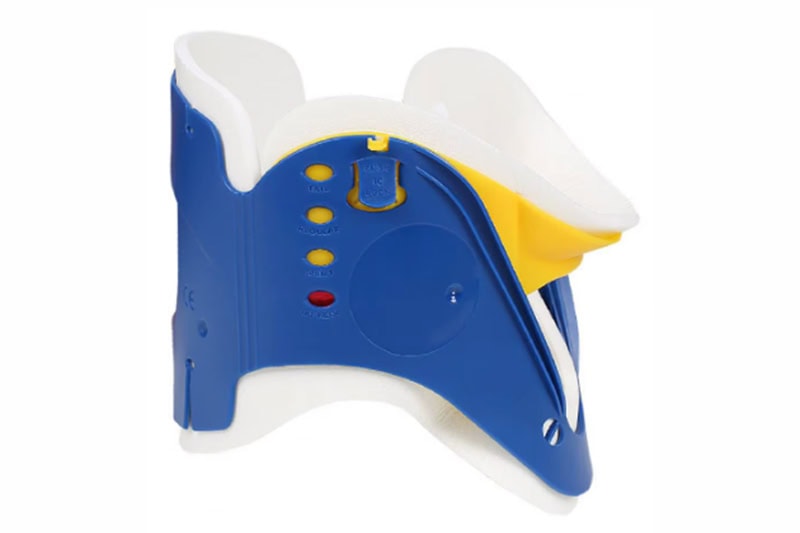
A cervical collar, also called a neck brace, is a medical device designed to provide support and immobilisation for the neck and spinal cord. It’s commonly prescribed for cervical spine injuries in trauma patients. These include soft and hard collars. These collars can be custom-fit to ensure proper support and reduce movement, and are typically made of breathable materials to reduce skin irritation.
Difference between Cervical Collar and Cervical Orthoses
A cervical collar is a type of cervical orthosis (CO) designed for short-term support to the head and neck. In contrast, CO is a broad term that includes more advanced devices used to stabilise the cervical spine. These range from short-term support of soft collars to long-term support by complex options like rigid cervical braces.
For a broader understanding of cervical collars, including their types, benefits, and usage tips, you can refer to the article titled Essential Guide to Cervical Collars.
Significance of Using a Neck Brace

A neck brace plays a crucial role in stabilising the cervical spine after neck injury or spinal surgery. It supports healing by limiting motion and reducing strain on muscles, bones, and nerves.
Head and neck immobilisation
During the healing process, reducing head and neck movement in the three planes of motion is critical to patient safety and recovery. This immobilisation can be achieved through the use of cervical collars, neck braces, and other cervical orthotic devices.
Support for the cervical spine
Cervical braces are used to support the cervical spine during neck surgery, injuries, and in some cases of chronic neck pain. It reduces the risk of further damage to the spinal cord.
Relief to neck muscles
By limiting movement, a neck brace reduces stress on neck muscles, helping to alleviate pain, muscle fatigue, and spasms. This muscular relief is especially important in conditions like whiplash or cervical spondylosis.
Types of Neck Collars

As already mentioned, neck collars are commonly divided into two types: Soft and Hard Collars. Soft cervical collars are often used for mild to moderate neck pain, while cervical hard collars are used for severe neck pain and spinal fractures.
Cervical Hard Collar
Hard collars, made of plastic or plexiglass, restrict head movement more. They are used for severe neck pain, spinal fractures, and traumatic injuries. In post-operative care, hard collars are considered the right option.
Cervical Soft Collar
Soft cervical collars are made of foam or other soft materials and fit snugly below the jaw. They provide limited immobilisation for mild to moderate neck pain. These are used for minor injuries like whiplash. While the primary aim of soft collars is to ensure comfort, rigid collars prioritise safety over comfort in serious spinal cord injuries.
You can view Jiekang’s full range of reliable cervical collars and other rescue products here.
Comparison of Soft and Hard Cervical Collars

Cervical collars—both soft and hard—are prescribed for a variety of neck conditions, from minor sprains to post-surgical stabilisation. While both types aim to restrict neck movement and support healing, they differ in terms of structure, comfort, clinical effectiveness, and patient adherence.
| Feature | Soft Collar | Hard (Rigid) Collar |
|---|---|---|
| Material | Foam or cotton + Velcro | Polyethene + foam liner |
| ROM Restriction | 10-20% (mild)* | 50–75% (high)* |
| User Comfort | High (foam density-dependent) | Moderate to Low |
| Best For | Strain, whiplash, muscle tension | Fractures, post-op, instability |
| Washability | Usually machine-washable | Wipe-clean shell, foam liner removable |
| Price Range (USD) | $12–35 | $40–120 |
Immobilisation and Clinical Application
Understanding how each collar type functions in immobilising the cervical spine helps guide appropriate clinical use.
Hard Collars: Maximum Support
Hard collars are used when strong neck stabilisation is needed. They limit movement in all directions: forward, backwards, sideways, and rotation. This makes them ideal after trauma, surgery, or spine fractures. Their rigid design helps prevent further injury and supports healing.
Soft Collars: Gentle Restriction
Soft collars offer light support and are mainly used for minor neck issues. They allow more movement and focus on comfort. These collars help reduce muscle strain and serve as a reminder to limit motion. They’re not meant for serious injuries but can ease pain in mild cases.
Comfort, Material, and Fit
A detailed clinical comparison highlighting the differences in comfort, structure, and use of soft versus cervical hard collars:
Soft Collars: Breathable and Gentle
Soft collars are typically made from polyurethane foam covered with a cotton or polyester fabric. This combination offers flexibility and breathability, making the collar more tolerable for extended wear. Various foam densities are available, allowing patients to choose between higher support or softer cushioning depending on their needs.
One of the key advantages is hygiene. Many soft collars come with removable and washable covers that help prevent skin irritation and maintain cleanliness during long-term use. Their lightweight design and skin-friendly materials make them particularly suitable for sleep and mild cervical pain management.
Hard Collars: Structured but Rigid

Hard collars, in contrast, are constructed from rigid materials such as moulded plastic or fibreglass. To prevent pressure sores and improve comfort, they often feature padded inner liners and secure Velcro straps for proper fitting. Advanced models like the Aspen Vista or Miami J offer customised adjustments, including height settings and interchangeable pads, to enhance comfort and ensure better anatomical alignment.
While these collars provide superior immobilisation—essential after trauma or surgery—their rigid build may cause discomfort during prolonged use. As such, they are typically reserved for acute injury phases or short-term immobilisation, rather than everyday wear.
Price Tiers Explained
Soft collars are more affordable and widely available in local pharmacies. Rigid collars, especially branded types like Aspen or Miami J, are more expensive due to advanced adjustability and clinical-grade materials.
| Tier | Collar Type | Features | Price Range |
|---|---|---|---|
| Basic | Soft | Flat foam, single Velcro, no cover | $12–18 |
| Comfort+ | Soft | Contoured foam, removable cover | $20–28 |
| Rigid Entry | Hard | One-piece, pre-sized | $40–60 |
| Clinical Pro | Hard | Adjustable height, washable liners | $80–120 |
Soft Cervical Collar: Comfort and Care Guide
Soft collars are generally preferred by patients for daily wear, sleep support, and low-level pain relief. This is because of their special material and construction. Most soft collars are made from polyurethane foam with a cotton or polyester cover. The outer shell is typically removable and washable.

Comfort Factors
- Foam Density: Higher-density foam offers more support but may be less comfortable.
- Breathability: Cotton covers improve airflow and reduce sweating.
- Velcro Quality: Poor-quality straps reduce lifespan and may cause skin irritation.
Pros
- Lightweight and comfortable for daily use
- Allows mild movement while offering support
- Preferred during sleep and for chronic pain relief
Hard Cervical Collar: Stability and Structural Support Guide
Hard cervical collars are engineered to provide maximum immobilisation, offering crucial support during post-trauma recovery or post-surgical healing. These collars typically feature a rigid plastic shell lined with foam padding, secured by adjustable Velcro straps. They restrict movement across all planes—flexion, extension, lateral bending, and rotation.
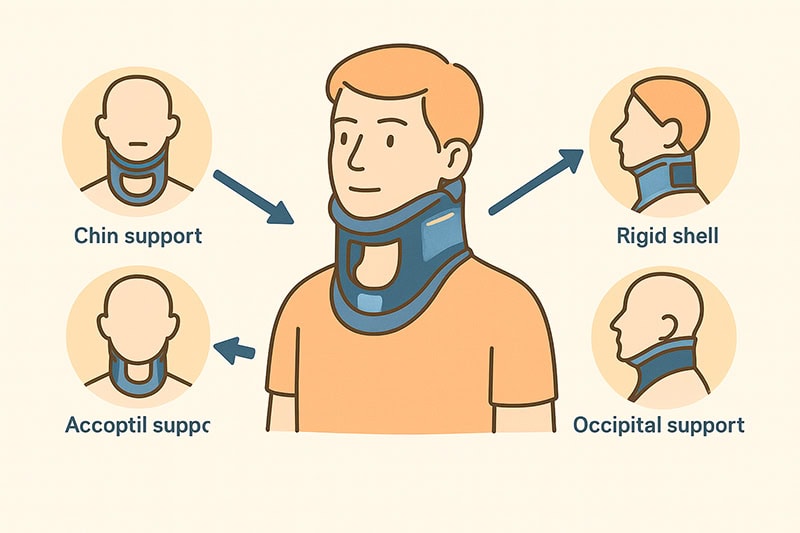
Support Factors
- Rigid Frame: Delivers firm control over neck motion to protect injured cervical spine segments.
- Chin & Occipital Support: Maintains spinal alignment and relieves pressure on neck muscles and neural structures.
- Adjustability & Padding: Some models allow custom sizing and have removable liners to improve patient comfort.
Pros
- Reliable immobilisation to promote safe healing
- Essential for managing cervical fractures and instability
- Provides targeted support to neck muscles and spine structure
Clinical Evidence Supporting Hard Collars
A randomised study of healthy subjects found that rigid cervical collars significantly reduce neck motion compared to soft collars. Rigid collars reduced cervical motion by approximately 59% in flexion and 18% in lateral rotation, compared to much lower reductions with soft collars—typically around 39% and 11% respectively. This supports the role of rigid collars in significantly limiting neck motion across multiple planes.
Choosing the Right Collar: Clinical Recommendations
| Condition | Recommended Collar |
|---|---|
| Minor strain/muscle tension | Soft Collar |
| Whiplash (Grade I–II) | Soft Collar (short-term) |
| Post-op cervical surgery | Hard Collar |
| Cervical fracture or dislocation | Hard Collar |
| Chronic degenerative neck pain | Soft Collar (limited duration) |
Always consult with a physician or specialist nurse before choosing a cervical collar or before deciding to stop wearing it. Overuse or incorrect fit—especially in hard collars—can lead to complications like neck stiffness, muscle atrophy, or pressure sores.
For professional advice, you can also contact our experts at Jiekang Medical for your specific needs.
Practical Guidelines for Cervical Collar Use
Here are certain essential tips to ensure safety, hygiene, and recovery of trauma patients.
Care and Maintenance
Cervical collars and neck braces must be cleaned regularly to avoid skin irritation and bacterial buildup. Using mild soap with warm water to clean dirty pads and plastic areas is usually sufficient for routine cleaning. Clean the front and back panels of the collar and replace the soiled pads with clean ones. Always follow the manufacturer’s care guidelines and consult a healthcare provider if unsure.
Complications and Risks
Wearing cervical supports for extended periods or without proper fitting can cause skin breakdown, pressure sores, or even muscle weakness. Following medical advice for correct wear time and maintenance can help prevent these issues.
Activity and Exercise
While cervical collars offer stability, light stretching and Gentle movement can reduce stiffness, improve circulation, and aid healing. Exercise should only be resumed under medical supervision to avoid further strain or injury.
* Note that prolonged wear can lead to muscle atrophy.
Fitting a Cervical Collar: Patient Care Protocol
Here is a step-by-step process for the proper fitting of a cervical collar on an injured patient. Proper collar fitting ensures effective immobilisation and prevents complications.
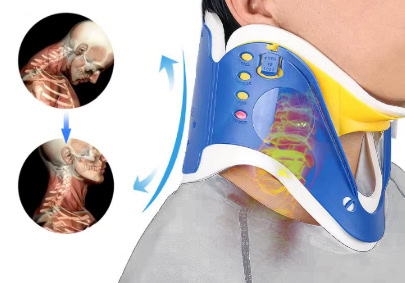
1. Introduce and Prepare
Explain the purpose and steps of collar placement to the patient to reduce anxiety and gain cooperation. Wash your hands and gather the appropriate collar type and size.
2. Position the Patient
Ensure the patient’s head is in a neutral position—neither flexed nor extended. If spinal injury is suspected, keep the head stabilised manually throughout.
3. Size the Collar
Measure the vertical distance from the trapezius (top of shoulder) to the underside of the jaw. Use a finger width (typically 2–4 fingers) to estimate or follow sizing guides provided with the collar.
4. Apply the Collar (Back First)
Gently slide the back portion of the collar behind the patient’s neck while maintaining head support. It should sit comfortably between the lower skull and shoulders. Long hair should be placed outside the collar.
5. Re-attach the Front Portion
Place the chin rest under the jaw, ensuring it supports without lifting the head. Bring the sides around and fasten them securely to the back piece using Velcro straps. Make sure they are in the same position as prior to removal.
6. Recheck Fit and Comfort
Ensure the chin is well-supported, the airway is not obstructed, and the collar is snug but not tight. Confirm the head and neck are well-aligned and the patient can breathe and speak comfortably.
7. Monitor and Reassess
Regularly assess skin for pressure sores, especially behind the ears and under the chin. Recheck collar alignment during movement or patient transfers.
For further advice, you can refer to the clinical protocol by the NSW Health Cervical Collar Care Guideline.
Conclusion
Choosing between a soft and hard cervical collar depends on the severity of the condition, patient comfort, and the level of immobilisation required. Soft collars provide gentle support, making them ideal for minor injuries and chronic neck pain. Hard or rigid cervical collars, on the other hand, offer stiff support and are essential in cases of trauma.
Proper care, correct fitting, and adherence to medical guidance are vital to ensure healing. Understanding the differences and appropriate use of each type empowers healthcare providers to make informed decisions for optimal cervical spine support.
For more information on choosing the right cervical collar or to explore available rescue solutions, you can visit Jiekang for expert assistance.

